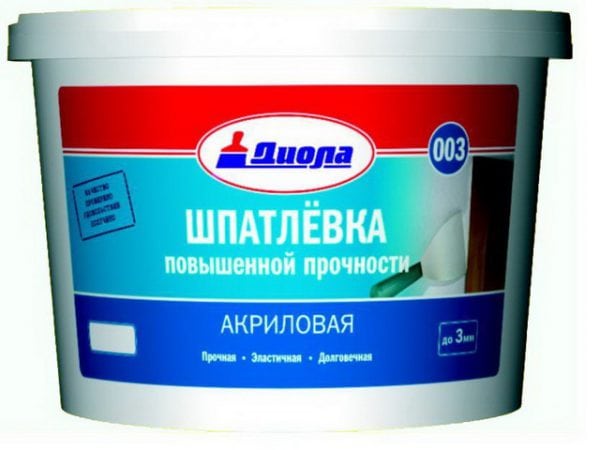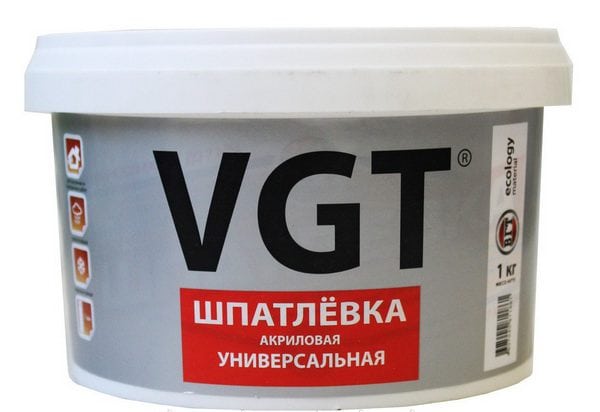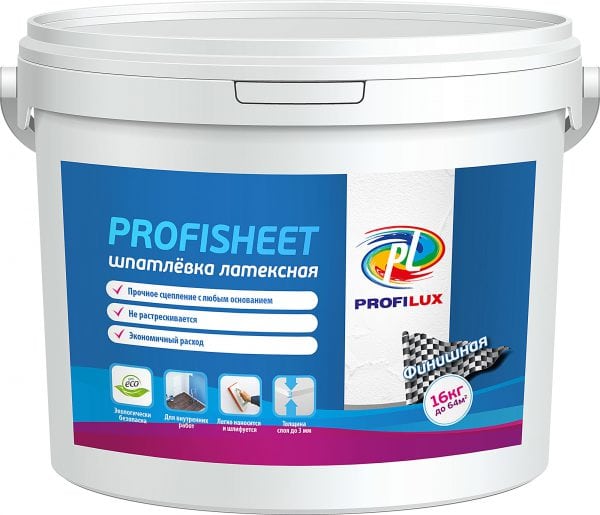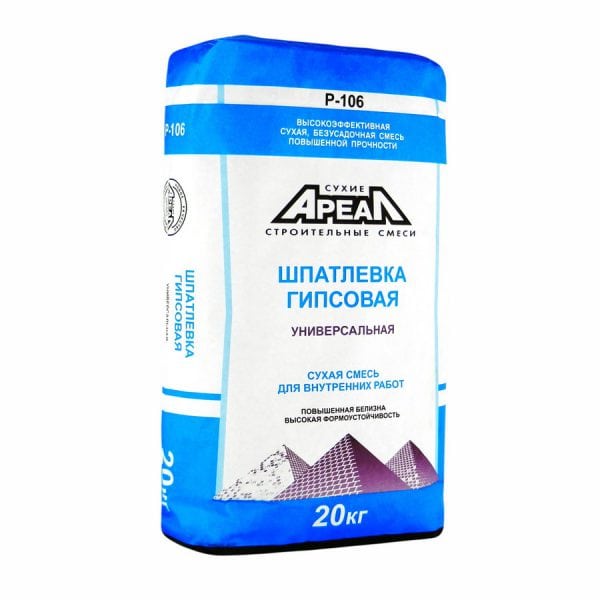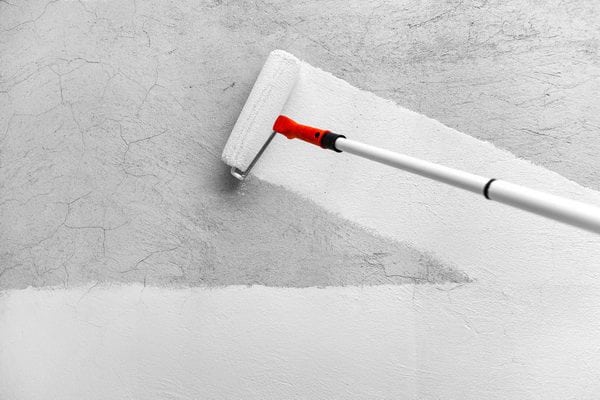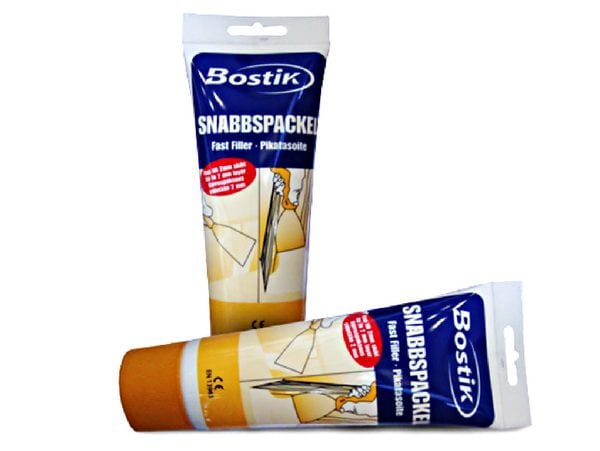Acrylic putty, due to its many advantages, is respected by builders. The features of this finishing material, as well as its application, will be discussed in this article.
- Material characteristics
- Differences from Latex Putty
- Comparison of gypsum and acrylic putties
- Putty Tips
- Putty of walls and ceilings
- Putty wood
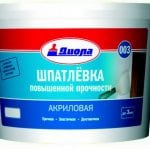
Material characteristics
The acrylic putty is based on acrylic, which is a synthetically manufactured substance with variable parameters.
Acrylic solutions have the following advantages:
- High ductility of the created coating. Due to this quality, the coating withstands significant temperature extremes, high and low temperatures, as well as mechanical stress. In this case, the putty surface does not crack and does not crumble.
- Excellent water-repellent indicators, in connection with which the base material is reliably protected from the harmful effects of moisture, as well as the formation of mold and fungus.
- The application of acrylic putty is simple. To process the surface, you will need a regular metal spatula or spray gun (for very liquid formulations).
- Fast drying time.
- The coating is easy to sand (albeit worse than gypsum) using an abrasive.
- Good heat-insulating qualities.
- Fire safety.
- Compliance with environmental safety standards.
- Excellent adhesion (adhesion of dissimilar materials).
- Lack of shrinkage.
- UV resistant.
- Long-term operation of the coating.
Acrylic compounds also have disadvantages:
- High price.
- Quick setting also has a downside: you need to work with the material very quickly, because after an hour the coating hardens.
- Non-ideal vapor permeability, which impairs moisture circulation.
The characteristics described above allow the use of acrylic for finishing all types of rooms and building facades. Acrylic solutions finish metals, concrete, brick, drywall, wood and plaster.
There are several varieties of acrylic compositions. The choice of a specific type of acrylic mixture depends on the nature of the surface to be treated.. For wood and concrete, water-dispersion solutions, which are highly waterproof, are best suited. For the decoration of external surfaces, facade compounds are intended. Universal mixtures can be used both for interior decoration and for processing facades.
Specialty fillings are also available, designed only for working with one or another type of material. For example, there are puttying compounds for wood, for drywall, for concrete.
Acrylic fillings are divided into starting and finishing. Starting coatings are designed to conceal the most significant surface defects and elevations. Finishing is used to “fine-tune” the already leveled coating, eliminating the remaining minor defects.
Acrylic putty is available in ready-to-use form. The solution is packaged in plastic buckets. It is convenient to use ready-made compositions, since there is no need for time and effort to independently prepare the solution.Unlike powder mixtures, liquid finished solutions retain their operational characteristics and practically do not thicken when carrying out puttying.
to contents ↑Differences from Latex Putty
Sometimes, in the absence of an acrylic putty in the store, sellers offer to buy latex. These compositions are in many respects similar, since in both cases the polymer component is used as the basis. At the same time, latex is still better in terms of performance. In particular, latex is characterized by higher strength, durability and resistance to negative environmental influences. Latex putties are also less prone to cracking compared to acrylic.
Just like acrylic, latex formulations are sold ready to use. Latex mixtures can be tinted in the desired color if desired.
to contents ↑Comparison of gypsum and acrylic putties
Gypsum putties are very popular, which is caused by both the qualitative characteristics of these mixtures and affordable prices. Below is a comparative description of acrylic and gypsum compositions:
- Gypsum is applicable only for finishing the internal surfaces of buildings, while universal acrylic putty can also be used for processing facades.
- Both gypsum and acrylates are equally well suited for leveling surfaces and masking defects.
- Acrylic compounds have a waterproof structure, and therefore reliably protect the base material from moisture. The gypsum coating easily absorbs liquid, which ultimately leads to swelling and gradual destruction of the material. As a result, gypsum is used only in dry rooms.
- Acrylates are much more plastic, which is why they are better adapted to sharp temperature extremes. In practice, ductility is expressed in maintaining the coating strength and the absence of cracking. Plaster coatings are not designed for extreme conditions. In the event of sudden changes in temperature, the coating crackes and peels off.
- Gypsum is characterized by better vapor permeability, but acrylates, due to the fact that they are waterproof, do not pass steam well. Thus, in rooms where gypsum was used, the humidity level will be more comfortable, and moisture will not settle on the walls.
- Gypsum mortars are easier to apply to the surface and easier to grind.
- Gypsum is an environmentally friendly material, which cannot be fully said about acrylic putty, which is produced by the synthesis of various chemicals.
- Acrylic compounds are much more expensive than gypsum.
- Acrylic outperforms gypsum in terms of indicators such as strength, reliability, and the maximum life of the coating.
- Acrylic mixtures are applied in a thin layer, so if the surface has significant flaws, additional coatings will be required. Gypsum mortar can be applied in such a thick layer that the first time will mask all surface imperfections.
Putty Tips
The following are recommendations for using acrylic formulations:
- Water-dispersion putty is suitable for wall treatment, but unsuitable for puttying the ceiling surface. For the ceiling, a universal composition is better.
- Putty should be applied only at positive temperature, but should not be too hot. The maximum permissible temperature for puttying is 30 degrees heat. If the temperature is higher, then you must either abandon the work, or regularly moisten the surface.
- The solution must be thoroughly mixed. If the solution was stored in a cold unheated room, then the putty should be left to stand at room temperature before use.
- The maximum permissible thickness of the putty layer is 3 millimeters. If the coating is thicker, it will become cracked.
- If the cracks are too large, it is better to first treat the surface with plaster, waiting for the final drying of the material before the next stage of work.
- The solution is applied with a metal spatula or with a spray gun.In the latter case, the solution must be diluted with a solvent. An airbrush is more often used for finishing, and a spatula is for starting.
- If there is a need for dilution of the composition, the amount of water in the solution should not be more than 0.5% of the total volume in the tank.
- Before proceeding to the finishing putty, the surface must be completely dry. The standard drying time is one day. However, the expectation may decrease or increase depending on temperature and humidity.
- The average consumption of putty material is in the range of 1.1-1.2 kilograms per square meter, provided that the layer thickness is 1 millimeter.
to contents ↑
Putty of walls and ceilings
Before the start of puttying, we prepare the surface: we remove the old layers of paint or other finishing material, we clear the material of dust, dirt, oil stains and other contaminants. If there are cracks on the coating, embroider them so that the putty completely fills these defects.
Next, apply a primer to the surface. When the primed surface dries, you can begin to putty.
For basic alignment of the walls, you can use both the starting and universal putty. Using a wide spatula, apply the putty on the surface. Movements are directed from top to bottom. As they dry, putty layers are ground with an abrasive. The top coat must be primed.
Note! To finish the facade surfaces produced texture putty. A feature of this material is the preservation of elasticity for a certain time after application. During this period, using the tool (grater, roller), the coating can give the desired relief or pattern.
Instead of painting, you can do with a finishing putty of a suitable color. Such a mixture can be bought already with a given color or you can add the desired pigment to the composition yourself.
to contents ↑Putty wood
Acrylic solutions are excellent for processing wooden products. Even dry old frames after putty gain the hardness of a new wooden product. Also, acrylic compounds are often used for the treatment of wooden floors, doors and other wood products.
Instructions for puttying wood:
- We remove the old paint or varnish from the surface.
- We grind the wood with the help of a sandpaper. It is necessary to remove all defects, roughness and roughness.
- We remove the dust that appears with a brush or sponge. If the area is large, use a vacuum cleaner.
- First, fill the obvious defects with putty: cracks, depressions, voids from removed knots, etc. If the cavity is too large, fill it in several passes, since the thickness of one layer should not exceed 3 millimeters.
- When the individual sections are processed, we remove the excess solution with the help of sandpaper.
- We apply the composition to the main surface and stretch it with a spatula parallel to the wood fibers. The peculiarity of working with wood is that it is not recommended to grind the putty coat, so as not to damage the base material. Therefore, the applied layer must be very neat and thin.
Advice! If the tree will not be painted in the future, you can choose a putty for the natural color of wood.
Although there is nothing complicated in puttying, when working with most types of putties, beginners almost never succeed in doing quality work the first time. Acrylic compounds compare favorably with others in their elasticity, and therefore, the ability to correct defects. Therefore, even for beginners, everything should work out.

